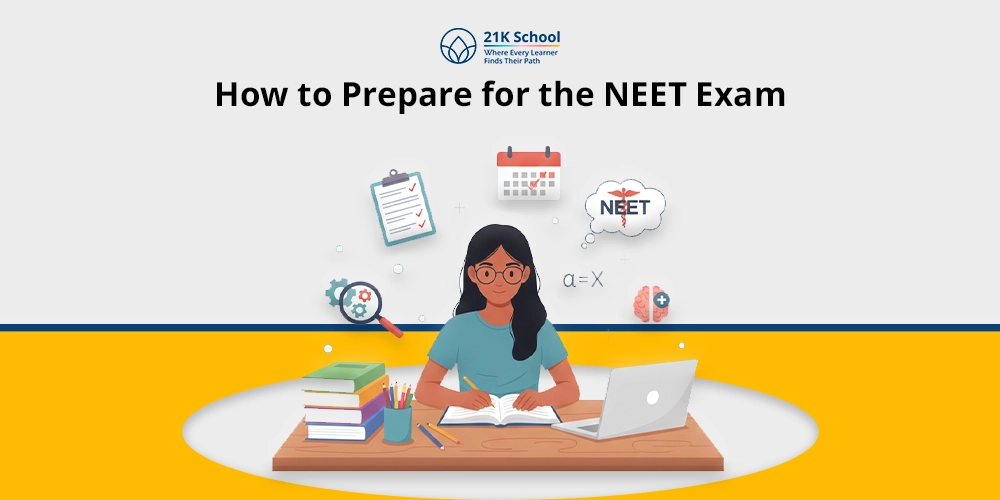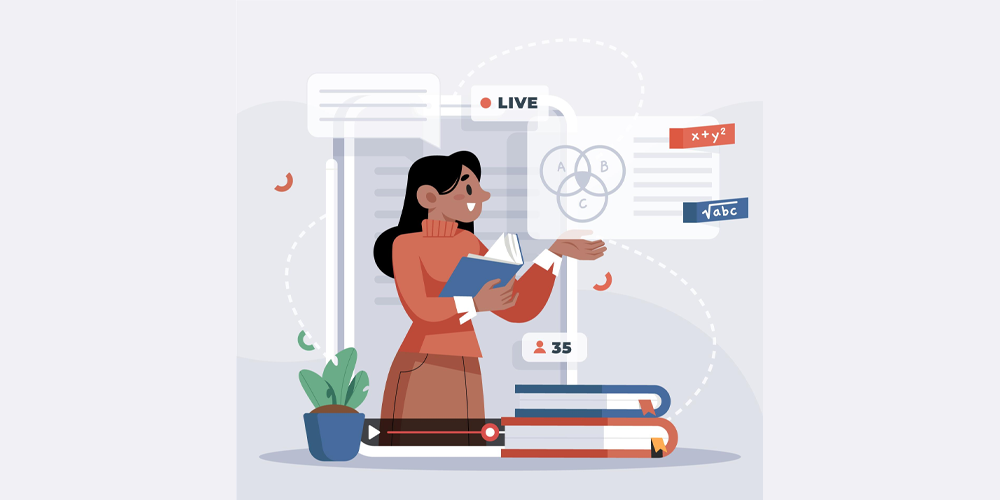
Personalised learning is a revolutionary educational approach aiming to customise learning for students.
Picture a classroom that approaches students according to their needs, skills and interests, strengthening their learning based on what they know and how they learn best.
To build a successful system of personalised learning it is important to acknowledge that every student has their own personalised set of skills that works best for their interest.
It is an approach that tailored educational experiences for every student to meet their unique needs and preferences. (Gone are the days that one size with all kinds of education personalised learning is a journey that respects students’ pace, strength , areas of growth and their abilities.)
Gone are the days when a one-size-fits-all approach defined education. Personalised learning is a journey that respects each student’s pace, strengths, areas for growth, and unique abilities.
But what is personalised learning?
In simple words, it is a flexible and adaptive approach to empower students by providing them with a customised educational experience.
Learners today seek a creative and engaging educational experience. In this teaching model, each student is provided with a personalised learning plan tailored to their skills and interests, ensuring an education that resonates with their unique needs.
Contents
- 1 How Effective is Personalised Learning?
- 2 The Power of Personalised Learning
- 3 How Should Personalised Learning be Used in the Classroom?
- 4 Benefits of Personalised Learning Experiences
- 5 What are the Common Barriers to Personalised Learning?
- 6 How It Addresses Diverse Learner Needs?
- 7 Implementing Personalised Learning: Strategies for Teachers and Parents
- 8 The Role of Technology in Personalised Education
- 9 Conclusion
How Effective is Personalised Learning?
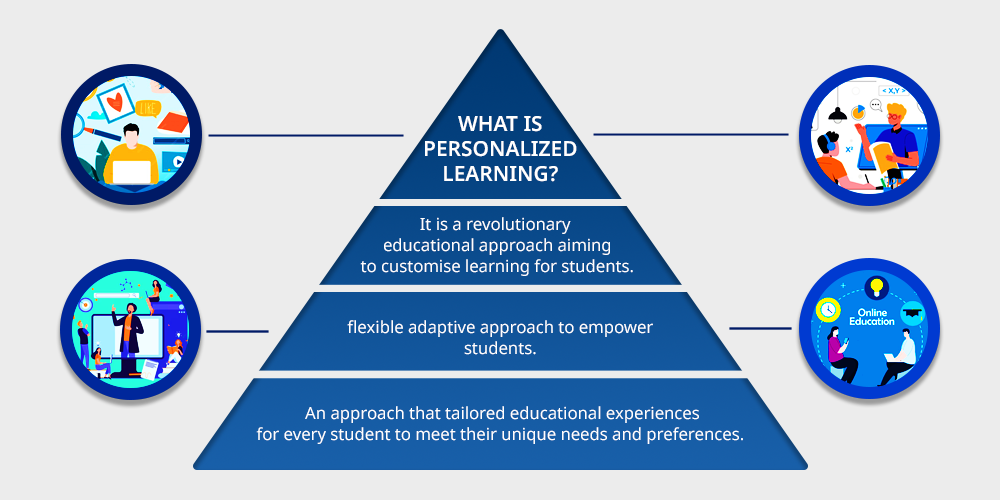
Personalised learning is not a new concept. It has been evidenced through history how over the years the concept of differentiated instruction boasts an impressive percentage in improving students’ attentiveness, inquisitivity and understanding.
Approximately 60% of students often disengage from classroom studies in a traditional learning setup.
In implementing a system that caters to personal learning styles, abilities, and preferred rate of learning, the student gets a better grasp of the course and acquires a higher level of self-confidence.
Studies show that students in self-paced learning environments achieve higher academic performance. This approach empowers them to take ownership of their learning journey, fostering responsibility and deeper engagement with the material.
Moreover, this approach encourages students to become creative thinkers and effective problem solvers by engaging with content in meaningful and personally relevant ways, tailored to their unique perspectives and needs.
The Power of Personalised Learning
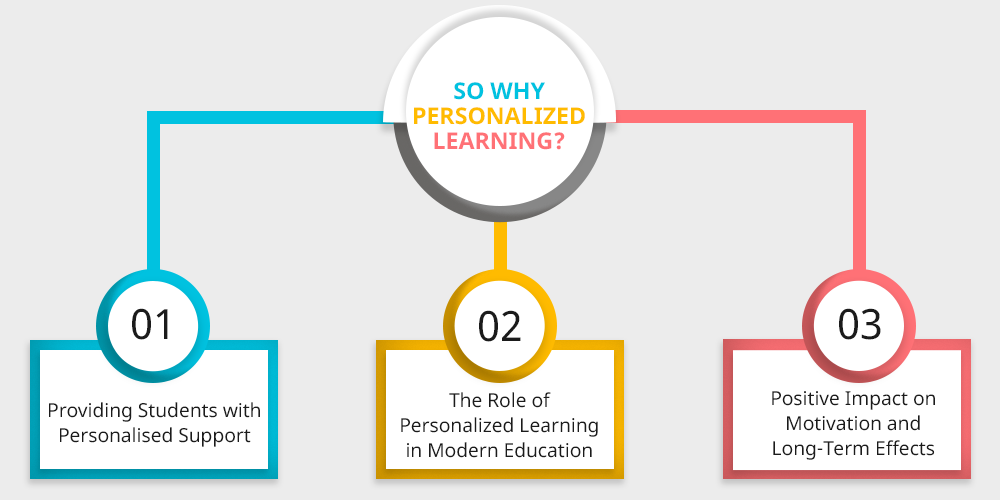
“We cannot teach students well if we do not know them well. At its heart, personalised learning requires profound shifts in our thinking about education and schooling.”
Personalised learning is known to improve learning outcomes and provide better engagement to students boosting their knowledge retention power. With the rapid advancement of technology, personalising content has become more essential than ever.
Personalised feeds have become integral to our lives, from social media updates to movie recommendations and curated playlists.
Similarly, to ensure relevance and impact, the knowledge imparted to our children must be tailored to align with their growth strategies and evolving skill sets.
This approach not only fosters self-awareness but also optimises time by enabling learners to engage with new topics more effectively.
It enhances interactivity and boosts motivation, making the learning experience more dynamic and fulfilling.
So, what do they help us with? The major three merits of personalised learning include :
1. Providing Students with Personalised Support
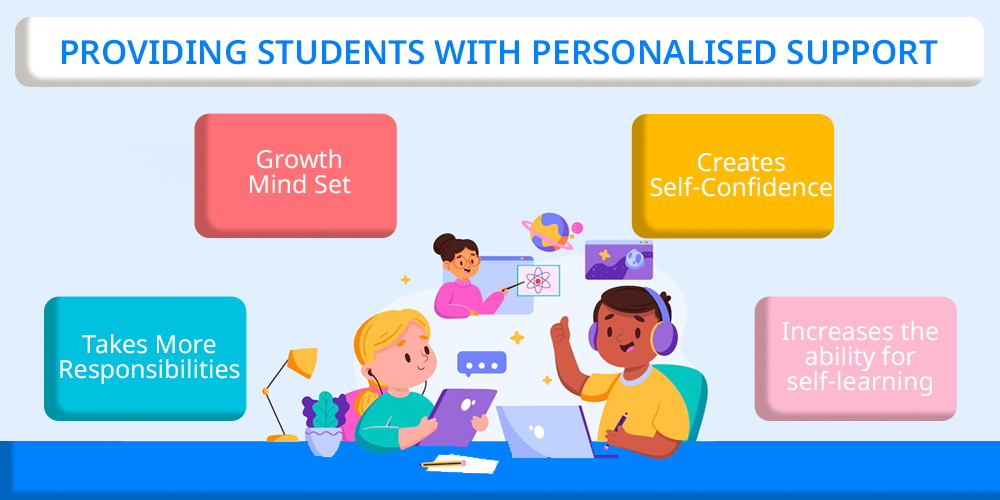
Personalisation is not only content adaptation; it is the key to providing the students with the required tools to succeed.
A student could easily feel left out or neglected, especially in a normal class setting if they are unable to make head or tail when it comes to certain lessons.
This shifts with personal learning as teachers can provide student support through one-on-one, online sessions, and learning maps.
The present study states that students who experienced caring support from the teacher were more likely to take more responsibilities while learning and embrace the growth mindset.
This approach helps the students to know that intelligence is not a terminal thing but something one has to work at to gain.
This also creates self-confidence and increases the students’ ability for self-learning, thus creating lifelong learners.
2. The Role of Personalised Learning in Modern Education
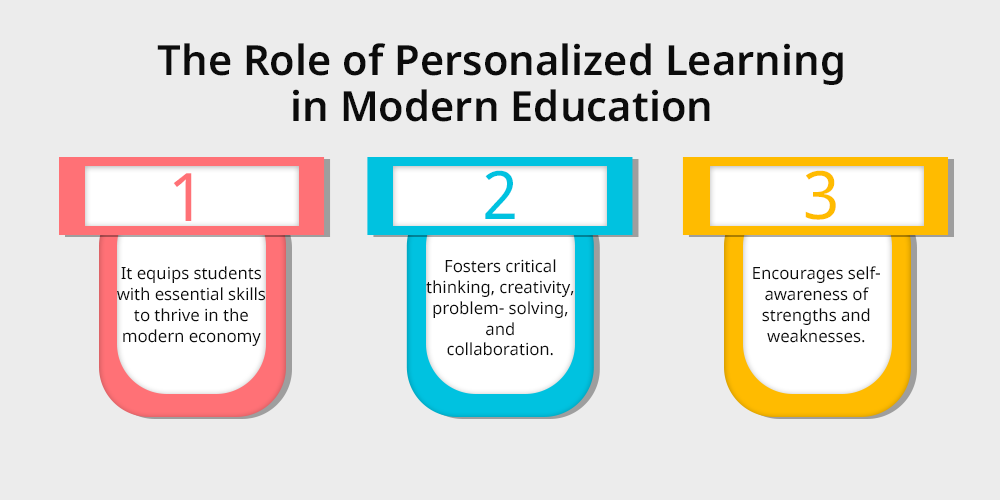
When it comes to present-day education, we understand that the personalisation of learning needs to address the swiftly changing world.
With increasing technology adoption and demand for skill development, traditional education systems—with rigid curricula and standardized delivery—fall short in preparing learners for the dynamic challenges of the modern world.
Personalised learning equips students with essential skills to thrive in the modern economy, fostering critical thinking, creativity, problem-solving, and collaboration.
By encouraging self-awareness of strengths and weaknesses, this approach builds the competencies vital for success in today’s world.
3. Positive Impact on Motivation and Long-Term Effects
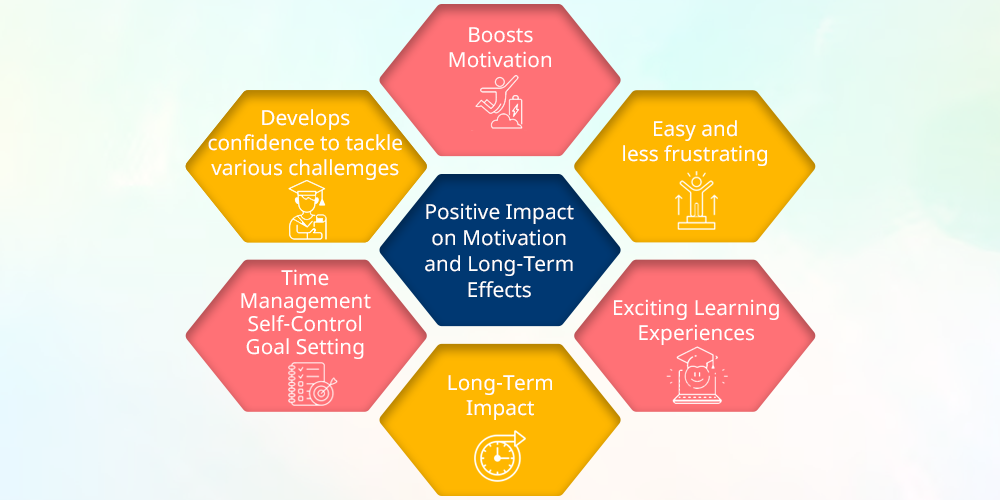
Another significant benefit of personalised learning is that it boosts student motivation.
With a more tailored approach, learners find studying easier and experience less frustration compared to traditional classroom settings.
When motivation is present, success naturally follows in the classroom. Another advantage of personalised learning is that it keeps students excited and eager to embrace each new phase of their learning journey.
The benefits of personalised learning extend beyond the classroom, particularly in the long run.
It helps students develop essential social-emotional skills, such as time management, self-control and goal setting, which are crucial for personal and professional success.
Academic skills are crucial in adulthood, whether pursuing further education or entering the workforce.
Students who experience personalised learning often develop the confidence to tackle various challenges and adapt to different situations effectively.
How Should Personalised Learning be Used in the Classroom?
At the classroom level, personalised learning can be implemented in various ways.
By understanding each student’s learning profile and performance, teachers can create tailored learning strategies that address individual strengths, needs, and goals.
To support personalised learning, various tools can be utilised, including adaptive learning technologies, small group instruction, project-based learning, and continuous feedback.
Teachers need a clear understanding of these tools and should regularly assess progress, making necessary adjustments to ensure lessons remain engaging and manageable for students.
The personalised learning approach will ensure that all teachers provide differentiated learning, and incorporate collaborative activities to ensure that low achievers have a reason to excel.
At 21K, we ensure that every student has a personalised learning experience, offering clear guidance and ample opportunities to explore their strengths, discover their potential, and excel.
Benefits of Personalised Learning Experiences
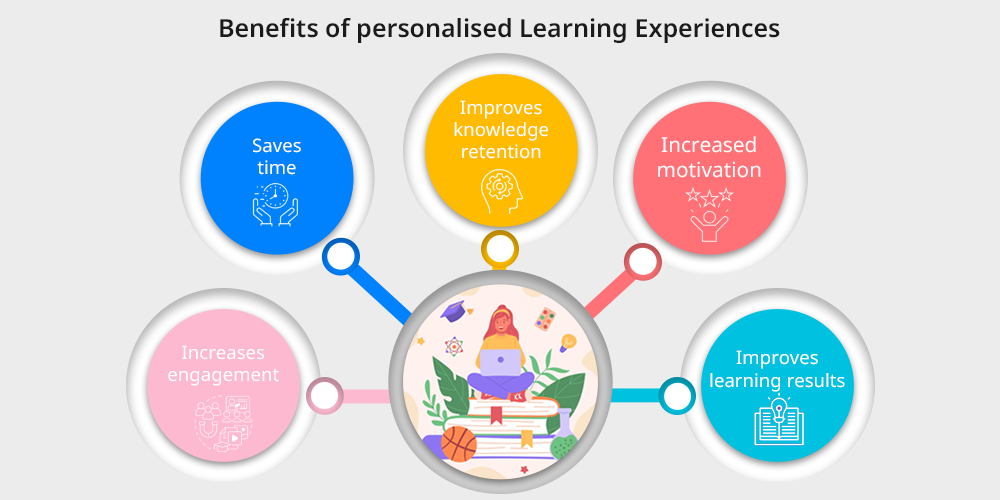
One of the key benefits of personalised learning is that it captures students’ attention and builds the confidence to question, explore, and engage with the world around them.
This curiosity-driven approach fosters deeper interactions and significantly boosts educational achievement.
So, what are the benefits of personalised learning experiences? While there are many, here are five key aspects that highlight how it shapes a child’s future and paves the way for success.
- Increases Engagement: When content is personalised, learning is more engaging and the learner is more attentive.
- Saves Time: Personalised learning reduces the time needed to grasp concepts and acquire skills, making the learning process more efficient and focused.
- Improves Knowledge Retention: Personalised learners can retain their information, based on their past experiences.
- Increased Motivation: Relevant information motivates students to keep the learning process actionable.
- Improves Learning Results: A personalised learning approach is meant to yield better learning results for students.
By tailoring teaching methods to suit different learning styles—visual, auditory, and kinesthetic—students are more likely to understand and retain information.
Identifying key areas where support is needed boosts confidence, leading to significant academic progress. The advantages of personalised learning extend far beyond these points.
Additionally, personalised learning fosters a deeper understanding of subjects and real-life values, allowing students to learn at their own pace while embracing their unique strengths and individuality.
The pressure to keep up with the entire batch comes to an end, creating an environment best suited for a profound learning experience that values mastery over speed.
What are the Common Barriers to Personalised Learning?
While personalised learning has many advantages for children and their overall academic success, there are also challenges that students have to face while transforming their journey from traditional to personalised or even starting fresh as a personalised learner.
Common barriers include:
- Limited Availability of Resources: Schools often lack the technological tools, curriculum flexibility, or funding to support individualised learning, in a way that contributes to their journey effectively.
- Teacher Training: Educators may need specialised training to manage personalised learning plans and leverage adaptive technologies, lack of resources can be a major reason for the training to not be that well equipped.
- Time Investment: Preparing a unique learning plan and providing one-on-one support can be time-intensive.
- Standardised Testing: The emphasis on standardised tests can make it difficult for teachers to stray from traditional curriculum frameworks, though striking the balance between both and accommodating transitional frameworks can be of great help.
Addressing these barriers involves investing in resources, training, and equitable practices to ensure personalised learning is accessible and impactful for every student,
How It Addresses Diverse Learner Needs?
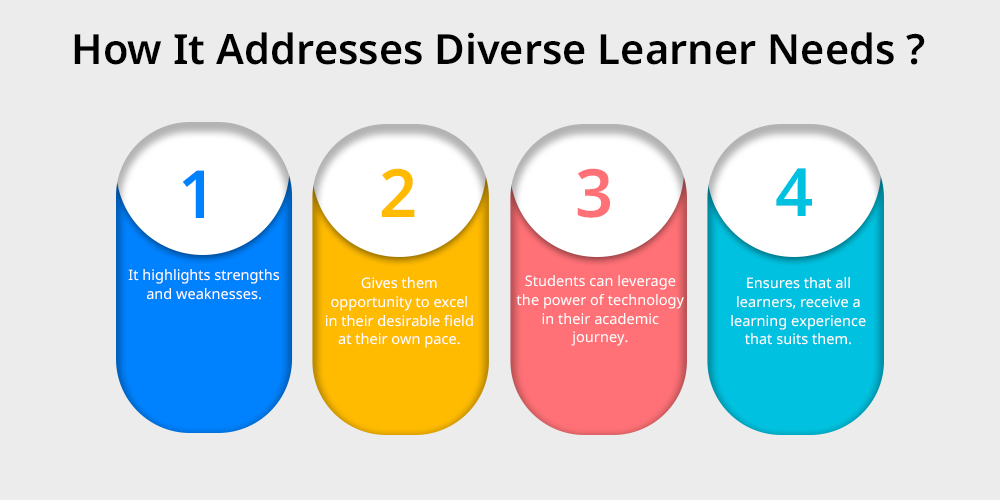
When we talk about learning experience, it mainly highlights our strengths and weaknesses, and every student comes with their own set of experiences.
The traditional teaching method often fails to meet the needs of diverse groups, strangling them in their records of marks, achievements and results without reflecting well on their skills, leaving them disengaged and bored of the learning process.
Personalised learning provides students with the opportunity to excel in their desirable field at their own pace adapting the tools that will ultimately help them in growing.
Students can leverage the power of technology in their academic journey by using assistive tools and customised resources.
Similarly, gifted students can take help from the resources designed for them to keep themselves engaged and challenged at all times to learn and grow more, ensuring that all learners, regardless of their academic background, receive a learning experience that suits them.
Implementing Personalised Learning: Strategies for Teachers and Parents
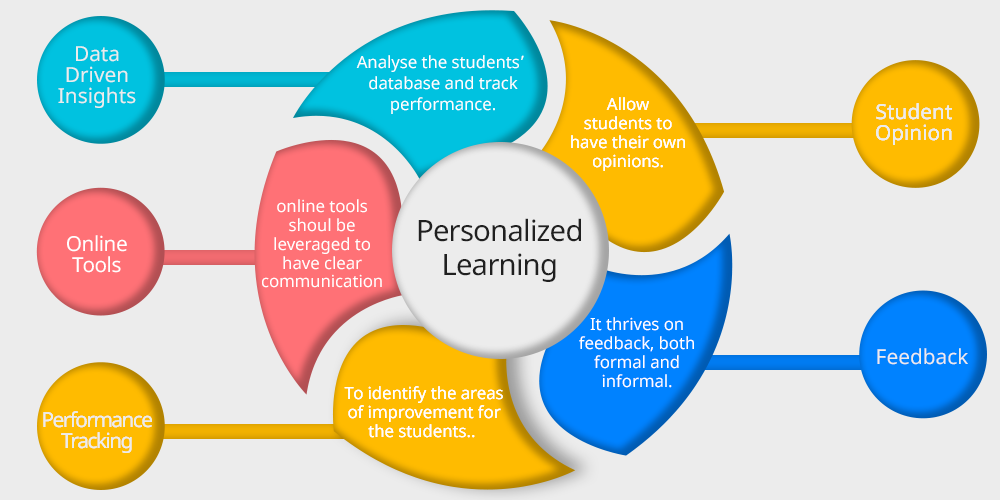
1. How can teachers put it into action and maximise its potential?
Teachers play a very important role in implementing personalised learning and shaping the curriculum for students based on their preferences and needs.
To start with, teachers can Use Data-Driven Insights to analyse the students’ database and track performance. The teacher will have to see where the students are excelling and what are the areas where he/she can help them.
It is important to allow students to have their own opinions their learning path with proper guidance and strategy.
Personalised learning thrives on feedback, both formal and informal. And, thus it is important to track performance and constantly keep identifying the areas of improvement for them.
Tools such as learning management systems and other online platforms should be leveraged to have clear communication between parents and students.
These tools can act as an interface for everyone involved to have clear and transparent communication, for various purposes: attendance tracking, assessments, feedback and even suggestions. They can even introduce various learning methods for better results.
2. How can parents be assured of this new personalised system?
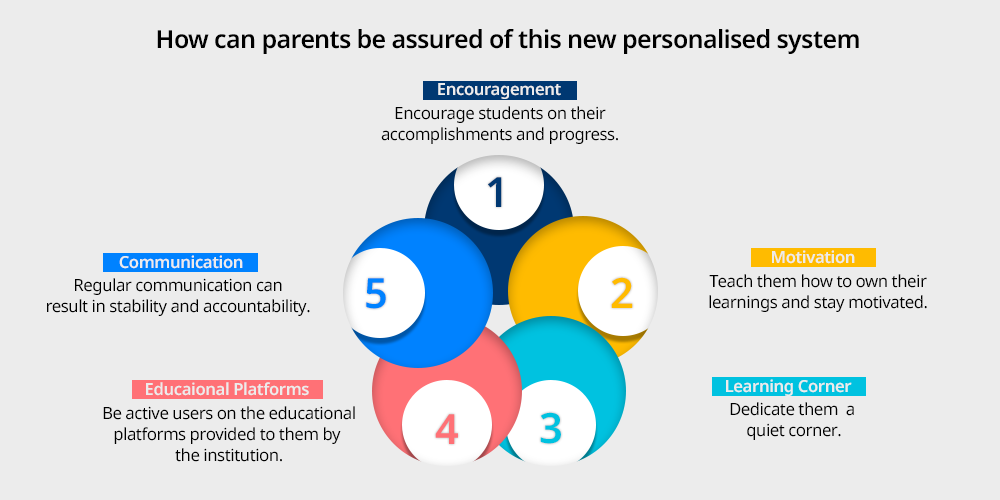
Parents are a very important part of students’ academic journey and they can support their children with personalised learning at home.
Students reflect on their own accomplishments and progress when encouraged. It is very important to teach them how to own their learnings and stay motivated. It is easy to transform their journey with virtual learning platforms.
Parents can start these small steps of dedicating a quiet corner for them providing them with all necessary support required and brief them with tips for successful learning.
They can be active users on the educational platforms provided to them by the institution, regular communication can result in stability and accountability for academic progress.
For any such more help and guidance parents can refer to blogs written dedicatedly on how parents can help their children in succeeding online classes
The Role of Technology in Personalised Education
In regard to the use of technology in the delivery of learning models, we need to focus on three areas; customisation, access, and flexibility as key aspects of personalised learning.
Facilities including LMS, many-levelled adaptive learning platforms, and data analytics, give the teacher ways to observe student progress, change lessons, and respond instantly, providing them with a platform to interact and track.
Another perspective of learning engagement is also supported by VR and incorporating game-based learning, modern-day gamification plays a very important role in attention-grabbing and quick learning promoting retention and excitement for students, in the era of virtual education.
Thus, technology applied to the personalisation of education can become a driving force for change in the process of classroom teaching and enhancing students productivity to achieve higher results.
But technology should always be complemented by interpersonal contact since a teacher’s guidance is always important to a learner. At 21k students are introduced to the world of technology to benefit their overall academic advancement.
Conclusion
The concept of personalised learning is highly effective, capable of transforming education and empowering learners to reach their full potential.
By offering differentiated instruction, fostering motivation, and developing essential life skills, it enhances student engagement, builds self-efficacy, and boosts employability.
The success of personalised learning relies on collaboration among teachers and parents, as well as adaptability and continuous improvement throughout the process.
With the integration of technology, data-driven insights, and creative approaches, education can be tailored to benefit every learner, equipping them with the skills and mindset to excel in higher education and beyond.


